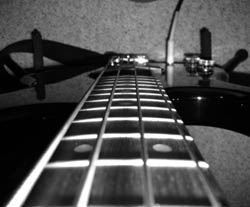
A great bass tone in the room is more likely to inspire a great performance. Now you need to capture and enhance it.
The Recording Chain:
—Mic selection – Dynamic mics and large diaphragm condensers are most common for bass amps. Spend some time comparing.
—Mic position – distance and angle play a big part as always.
—Direct Box (DI) – A direct box allows you to split the signal from the bass, one side continues to the amp, the other goes to a preamp.
—Microphone Preamp – Every preamp has its own tone. A pad option may be required.
—Compressor – Optional but worth testing if you have the option. Its very common to compress the DI track while recording in pro studios.
Record at a conservative level, if you’re really digging in for a grindy tone keep the peaks no higher than -6 dBFS (DAW metering). An average of anywhere from -18 dB to -12 dB is all you need. Dynamics will likely be reduced and additional processing is inevitable by the final mix. A clipped signal is useless.
Can you get a great bass recording with just a DI (or plugging right into the interface)? Yes. Can you get a great bass recording with just an amp? Yes. Splitting the signal with a DI before the amp and recording to two tracks gives you more flexibility when it comes to mixing. You may prefer the sound of one over the other, or a blend of the two.
When you do blend the DI and miked amp signals in your DAW it is very likely that you will hear some phase issues. The problem is caused by the DI signal gets to the interface before the mic signal does causing a slight delay.
Try inverting the polarity of one of the tracks. This will usually be a dramatic improvement in the low frequencies. This can further be improved by delaying the DI track, often just by a few milliseconds or even samples. You might find it easiest to start with the tracks “out of phase” then adjust the delay until you have the most cancellation, and invert the polarity again (now in phase). You may not get it to be absolutely perfect but do try to find the best compromise.
By now you should have a good, very usable, better than average bass track recorded into your DAW. We won’t get into processing and mixing bass in this article, if you really need info on that right now, check out the Sept 2011 issue of Sound On Sound, great tips on mixing bass in there.
Have a listen to the audio examples I’ve prepared. Compare the different playing styles, mic position, mic type.
In the delay compensation file, notice how the tone changes quite dramatically just by delaying the DI in increments of 10 samples.
Bass Recording Examples by RevolutionAudio
Jon Tidey is a producer/engineer who runs his own studio, EPIC Sounds, and enjoys writing about audio on his blog AudioGeekZine.com.
